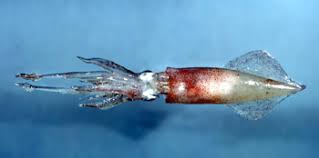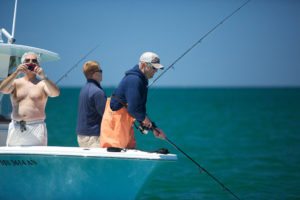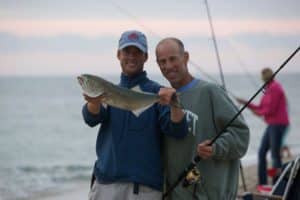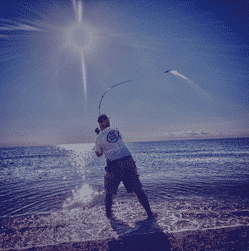Understanding the Squid Fishery, particularly as it relates to Nantucket Island.

Understanding the Squid Fishery, particularly as it relates to Nantucket Island.
The problem:
Squid are a migratory baitfish that feed our ecosystem. They have been locally over-harvested for the past seven years. Recent science suggests that a major spawning area for squid is south of Nantucket, Tuckernuck, Muskeget and Martha’s Vineyard. (Squid lay eggs in squid mops, which attach themselves to the ocean floor until they are mature enough to survive outside of the egg: incubation is 17-30 days) The problem is that in the last seven years, there has been a steady increase in small mesh bottom trawlers targeting squid south and west of Nantucket causing localized depletion. These trawlers are taking from our ecosystem between 8,000,0000-19,000,000 pounds of squid each summer. This is not to mention the incredible kill rate of the squid mops as they are also fishing directly on spawning grounds. All the while these trawlers are non-discriminatory leading to a 37% bycatch number.
More info on Squid:
Squid spend the winter months along the continental shelf and they do not move inshore until the water begins to warm in late April – Mid-May. The Squid come in waves to our local waters all of the way through August. They lay their eggs (mops) and fertilize them in the “shallows” during this period. Once done they continue their movement to the rips north and east of the island filling the water off of Chatham/Monomoy as well as Great Point and the rips southeast and east of Nantucket. When the squid eggs mature they get pushed with the tide into the warmer nutrient rich waters of Nantucket Sound or along the south shore of Nantucket. As they mature, they become squiddos and they also push through our ecosystem feeding the Bluefish/Striped Bass/Tuna that fill our waters in August/September. A squid’s life cycle is around one-year. In all stages of life, Squid are an essential food source for everything in our ecosystem. The mops are eaten by bottom fish, while the immature and mature are targeted by Striped Bass, Bluefish, Tuna, Albacore etc…
A brief history of the localized depletion for squid:
Squid are managed through annual quotas. The quotas are broken into seasonal trimesters. If a quota is hit in one trimester, the fisherman need to stop fishing. Since 2011, the fleet has not caught the quota for the spring Trimester. If they do not hit a previous quota trimester quota, that quota then rolls over into the next trimester. (maxing out at 50% extra of the quota). For example, in 2016 the fleet did not catch their allotment in the spring, so instead of an 8,000,000 lb quota in the summer, it went up to 12,000,000 lb. Historically, once the quotas are met, which in recent years, has only happened in the summer trimester, fisherman could continue to harvest squid as incidental catch, so long as it did not exceed 2500 lbs per trip. Squid for a long period did not have the value it does today, as a result allowing fishermen to bring in their incidental catch. This was a positive measure to ensure that there was not waste. As the value of squid quickly increased, fisherman would use the incidental catch loophole to extend their squid seasons. In 2016, this extra catch added up to 7,000,000 lbs. For a total haul of 19,000,000 lbs in the summer trimester in 2016. Due in large parts of the efforts of Nantucket fisherman, this extra quota has been reduced to 250 lbs a trip because of how it was abused in 2016. This is a win for our fishery! However the agency failed to finish the rule in time so the reduced trip limit won’t take effect until trimester two of 2019.
The biggest harvest of squid continues to be in Trimester 2 and there continues to be the highest effort concentrated south of Nantucket, at the time and place where spawning happens. On any given day, we’ll see 30-50 boats in the offshore waters. It’s our belief that the continued pressure on the spawning grounds will have a long term negative impact on the biomass of squid in our regional waters. Most notably, after the overfishing in 2016, we saw a significant decline of mature squid in 2017 and the quota was not met until late in Trimester 2. Squid are short-lived species and science shows that an increase in the catch of squid in one year reduces the population in the next.
Of other significant consequence, there is documented reports from NOAA observers on vessels of a 36% by-catch rate (this was an average between 2007 and 2015) A 36% by catch rate means that 36% of the total catch was by catch, in other terms if you caught 100lbs of squid there was over 50lbs of by-catch. For every 100 lbs of squid being caught, there is 50 lbs of by-catch. In 2017 observers witnessed a 50% by catch, meaning for every 100 lbs of squid taken, 100 lbs of by-catch were produced. Last year we had over 400,000 lbs of Striped bass discarded. That is half the states commercial quota! Maybe most importantly, between 2011-13 the observers witnessed and average of 32,000 lbs of squid mops a year. Considering the size of squid mops, that is an enormous number. All in all, there we 40+ species discarded, including but not limited to, Fluke, Black Sea Bass, Herring, Bluefish and Butterfish.
Lastly, predatory species, including Striped Bass and Bluefish which have long counted on squid as a major food source are at historically low catch rates. As we are seeing 8-19mm lbs of squid caught during trimester 2, our fin fish are not getting the food they need from our waters. It is no secret that Striped Bass come to the shoals around Nantucket for the squid and they often won’t feed unless we have squid, often moving on to other to target other prey including mackerel and sand eels. This trend has been continuing for the past seven years and the change in striped bass catch rates can be directly (inversely) linked to the amount of squid being harvested.
With respect to Harvesting Squid:
In Massachusetts State Waters (Inside of 3 miles)
In 90% of state waters small mesh bottom trawlers are not allowed to fish from May 1st – October 31st. This is a law that goes back decades. Nantucket happens to be in that 10%. Massachusetts small mesh bottom trawlers and those from out of state receiving permits are allowed to harvest squid inside state waters (the 10% allowed to mobile gear) from April 23rd until June 9th. This date can be extended by the department of Marine Fisheries and has historically not been extended until 2015. It was extended for three years until our community put a lot of pressure on the state to not extend this date. Last year, it was not extended. A win for the fishery!
Nantucket’s response to this:
It is our opinion; we should have the same protection as 90% of the state. In 90% of Massachusetts waters, inside of 3 miles is closed to mobile gear (dragging nets). In an effort to receive the same treatment, we (the town of Nantucket) have proposed legislation to protect our inshore waters. Our state reps have been incredibly supportive and in one year we have already seen the bill come out of committee. It is still an uphill battle but we are making progress.
In Federal Waters (Outside of 3 Miles)
Fisherman from any state are allowed to target squid in Federal waters until the quota for that trimester is met. They are allowed to use mobile gear which rips up the bottom, which dislodges the squid mops causing a high mortality rate. Further, it is indiscriminate towards bycatch. They are limited to the size of mesh they can use so small fish can escape, but it has been documented that the commercial fishermen will double up using a 5” over and 1” 7/8ths mesh, so even though they are using the correct size mesh, the layering makes it difficult for smaller squid and bycatch to escape. These fishermen do a good job of staying right on the three mile line so as to stay in federal waters.
Nantucket’s response to this:
We have been working hard to create a buffer zone (a time and area spawning closure) from 3 to 6 miles or 3 to 12 miles south of the Island to protect the reproducing squid. The design of a buffer zone is to not allow commercial fishing in a specific area so as to protect a designated species and the by-catch. This is not uncommon in other fisheries. Most fisheries protect known spawning areas, otherwise known as essential fish habitat. We petitioned the Mid-Atlantic Fisheries Council to address this matter, recognizing that Massachusetts is not represented on that body. To their credit, they have put it as an agenda item three times over the last two years, but they unfortunately chose not to consider a buffer zone in federal waters. The science is on our side. The squid fleet feels as though the strong squid population justifies the quota. We actually agree with the squid fishermen that the quota is sustainable if the proper gear is used (jigging and purse seining as they do it in the rest of the world) in responsible locations. Furthermore, it will be sustainable if the fleet does not target the spawning ground otherwise known essential fish habitats. We aren’t saying catch less squid, we are asking for it to be less concentrated, and more to be taken at times and places where there is less ecological damage and cost to local communities. Over and over we have seen species (notably Cod, Herring and Swordfish) populations hurt because of practices like we are seeing with the squid now. Further, it makes no sense for the entire fleet to be fishing in one location as it has a hugely harmful negative effect on the Cape and Islands recreational and commercial fishing for predatory fish. As the squid fishermen point out, the squid stocks (for now) are healthy so can’t these boats find areas offshore, like they historically did, to catch the squid and satisfy the market? Squid caught offshore would not directly affect a local economy. The only negative would be more fuel costs for the squid fishermen.
Nantucket Fisherman have received some wins including lowering the incidental catch loop-hole from 2500 lbs per trip to 250 lbs per trip. Unfortunately, this will not go into effect until 2019, so we can only hope the catch this trimester two does not exceed the limit. Saying this, we still have a long way to go. Unfortunately, the Mid-Atlantic Council has been weighted significantly towards commercial fisherman and the present council is not conservation minded. Even though the Council is willing to hear our argument once put up for a vote there are deep pockets behind the commercial fleet and the council is very politically minded. For example, the one voting member representing New England works for one of the largest squid fishing operations. As a result, we feel as though decisions are not being made in the fisheries best interest but in the short term interest of the fishing industry. This will be an exercise in patience as the model is currently set up.
Lastly-
Our newest fight is that Town Dock, the largest Calamari supplier in the country, has hired Marine Stewardship Council(MSC) to review and certify that the Longfin Squid fishery is a “sustainable seafood.” MSC is an independent entity that is paid by companies like Town Dock to certify that certain fisheries are sustainable. At its root, MSC was set-up to help industries understand and protect the fisheries, and they have ecosystem policies including standards for the management of forage fish like squid. MSC has looked at the science presented by Town Dock and is about to call the fishery sustainable, but they have not reviewed all of the science behind the certification, nor have they talked with any local “players” in the most targeted market. They have yet to speak with Nantucket’s Fishermen, which seems short signed if they want to fulfill their mission to be a credible international Steward and Certifier of fisheries. We are optimistic that if we can get MSC to the island and to hear all the information that we have that they will understand that the squid fleet’s current practices are damaging to the long-term viability of the fishery. They have the ability to create restrictions on the fleet in an effort to get the fishery certified.





